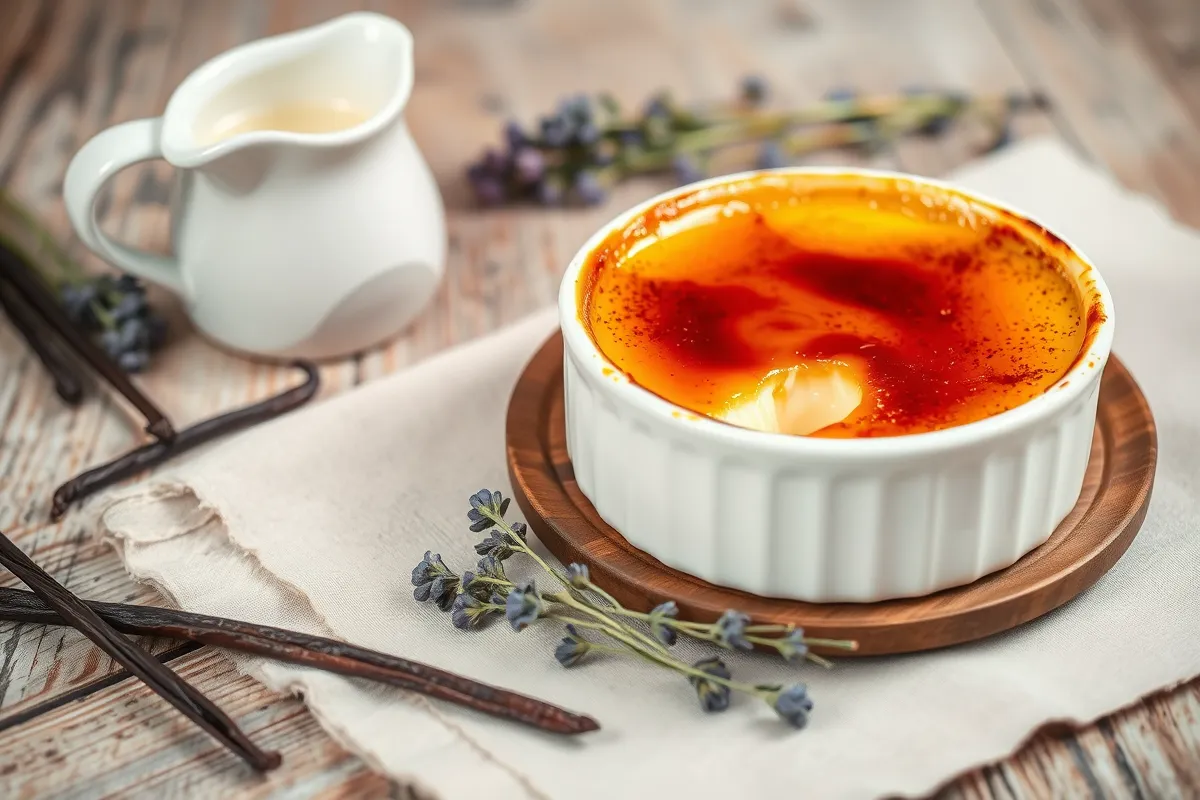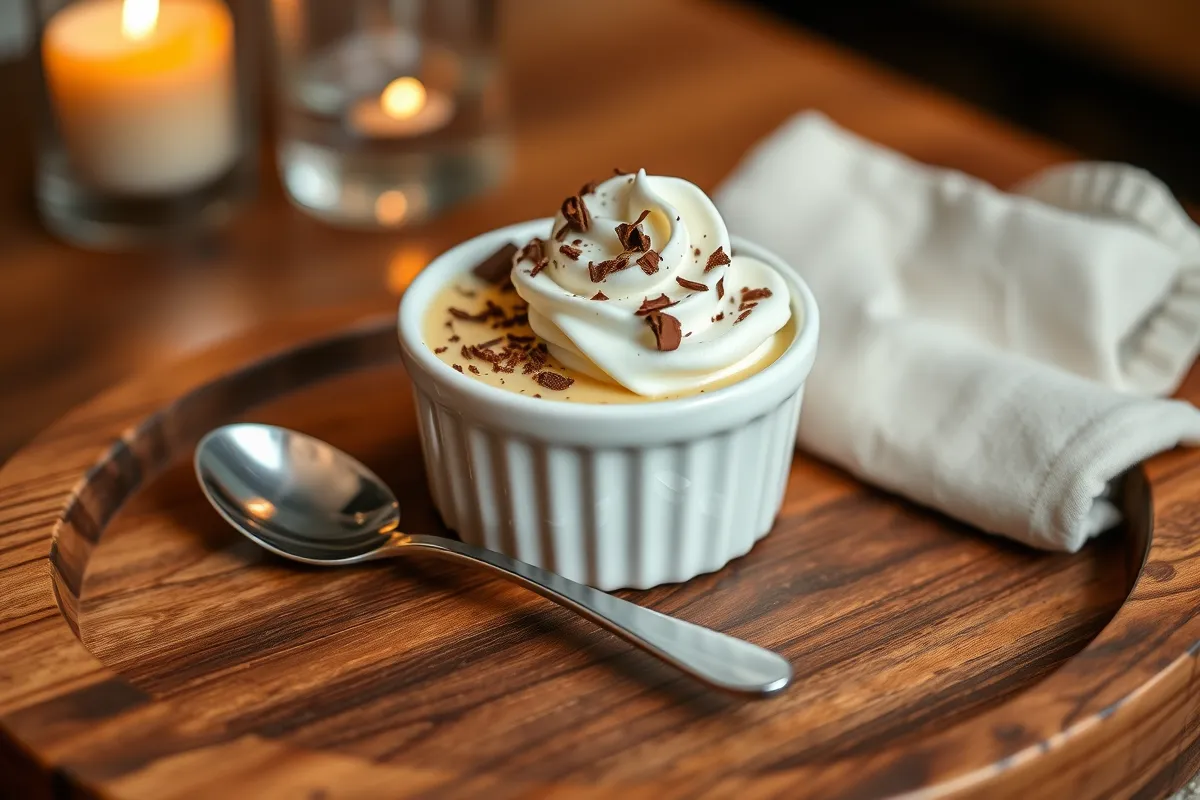French desserts are celebrated worldwide for their elegance, rich history, and irresistible flavors, with custard-based delights stealing the spotlight. From the creamy decadence of crème brûlée to the rustic charm of clafoutis, these culinary treasures exemplify the artistry and finesse of French pastry-making.
In this article, we’ll embark on a flavorful journey to explore the fascinating origins, famous examples, and foolproof preparation techniques behind these beloved desserts. Along the way, you’ll also discover pairing ideas that elevate their indulgent flavors and make them perfect for any occasion.
Whether you’re a passionate home chef eager to perfect your skills or a curious foodie looking to explore French cuisine, there’s something delightful waiting for you here. So, grab your whisk and prepare to immerse yourself in the creamy, silky world of custardy French desserts. Let’s dive in!
Introduction to Custardy French Desserts
What Defines a Custardy Dessert?
Custardy desserts are characterized by their silky, smooth texture and delicate flavor. At the heart of these creations is custard—a mixture of eggs, milk or cream, sugar, and flavorings, gently cooked to perfection. The balance between richness and lightness makes them a staple in French culinary traditions.
The key to a perfect custard lies in its preparation. By mastering the art of low, controlled heat, chefs create a creamy, velvety texture that melts in the mouth. Whether served warm or chilled, custards are versatile enough to be paired with a variety of flavors like vanilla, chocolate, caramel, or fruit.
The Origins of Custardy French Desserts
The roots of custardy French desserts can be traced back through centuries, deeply intertwined with France’s rich and storied culinary heritage. During the medieval era, innovative chefs began combining humble ingredients like eggs and milk to create simple yet satisfying puddings. Over time, these early creations gradually evolved, paving the way for the sophisticated and indulgent desserts we so passionately enjoy today.
As French culinary traditions advanced, pastry chefs introduced groundbreaking techniques that elevated custards to new levels of artistry. For instance, caramelizing sugar, a method perfected to crown the iconic crème brûlée, added an irresistible layer of flavor and texture. Additionally, chefs began layering custards with fruits or pastry, resulting in complex and visually stunning desserts that delighted both the palate and the eye. This continuous refinement not only solidified custards as a cornerstone of French cuisine but also showcased the endless creativity of French chefs.
Regions of France added their unique twists, such as the use of local fruits in clafoutis or chocolate in pot de crème. This evolution has cemented custard-based desserts as a hallmark of French cuisine. They’re beloved not only for their flavors but also for the artistry involved in their creation.
These delightful desserts, with their creamy textures and timeless appeal, continue to captivate dessert enthusiasts worldwide. Stay tuned as we explore famous examples like crème brûlée and the rustic pot de crème in the next section!
Famous Custardy French Desserts

Crème Brûlée: The Quintessential Custardy Delight
One of the most iconic French desserts, crème brûlée combines cream
y custard with a perfectly caramelized sugar crust. Its name translates to “burnt cream,” highlighting the signature torching process that creates its crispy top layer. This custardy French dessert is typically infused with vanilla, though variations include flavors like orange zest, lavender, or coffee.
The dish dates back to 17th-century France, though some claim earlier origins. Regardless of its roots, the dessert has become synonymous with sophistication. Preparing crème brûlée requires precision—baking it in a water bath ensures the custard stays silky and smooth.
For a deep dive into mastering the art of caramelizing sugar, visit The Secret of Crème Brûlée.
Pot de Crème: Elegance in a Jar
Pot de crème, which means “pot of cream,” is a dessert of understated elegance. Typically served in small pots or jars, this dessert balances richness with subtle sweetness. Chocolate is a popular choice for pot de crème, but vanilla and caramel variations are also beloved.
Dating back to the 18th century, this custardy French dessert reflects the refined tastes of the French aristocracy. The slow-baking process ensures a creamy, dense texture. Adding a dollop of whipped cream or a sprinkle of sea salt elevates its flavors even further.
Clafoutis: A Rustic Custard Treat
Unlike its more refined counterparts, clafoutis exudes a charming rustic appeal. Originating in the Limousin region of France, this dessert is a cross between a custard and a cake, often made with cherries baked into the batter. Variations include pears, plums, or berries.
Clafoutis is delightfully simple to make. Its batter resembles pancake mix, poured over fruit and baked until golden. This dessert is perfect for showcasing seasonal produce, making it a staple in French homes.
Other Popular Variations
French cuisine boasts numerous custard-based creations, from savory quiches to sweet tarts. Examples include:
- Flan Parisien: A creamy custard tart with a flaky crust.
- Île Flottante: Whipped meringue floating on crème anglaise.
For additional dessert inspiration, explore Bavarian Kreme Donut Recipes.
How to Make a Perfect Custardy French Dessert
Essential Ingredients for Custard-Based Recipes
The foundation of any custardy French dessert includes simple ingredients: eggs, milk or cream, sugar, and flavorings. While vanilla is a classic choice, other flavorings like orange blossom or almond extract can add intrigue. High-quality ingredients, such as fresh eggs and pure cream, are essential to achieve a rich and luxurious taste.
Techniques to Achieve Silky Smooth Custard
The secret to velvety custard lies in technique. Here are some tips:
- Low and Slow Cooking: Baking custards in a water bath prevents curdling and ensures even cooking.
- Proper Mixing: Whisk eggs and sugar gently to avoid incorporating too much air, which can lead to a grainy texture.
- Straining the Mixture: Pour the custard through a fine sieve to remove any lumps before baking.
Common Mistakes to Avoid
Even seasoned chefs can encounter pitfalls when making custard. Here’s how to sidestep them:
- Avoid High Heat: Custard cooked too quickly can curdle or develop a rubbery texture.
- Don’t Skip the Water Bath: The steam created by the water helps stabilize the custard during baking.
- Monitor the Temperature: Use a thermometer to check for doneness; custard is ready at 170–175°F (77–80°C).
With these tips in mind, you’ll be ready to create a flawless custardy French dessert that delights every palate.
Nutritional Information for Custardy French Desserts
Nutritional Content (Per 100g)
Here’s the approximate nutritional breakdown for a typical custardy French dessert like crème brûlée:
| Nutrient | Amount (Per 100g) |
|---|---|
| Calories | 240 kcal |
| Protein | 4 g |
| Fat | 18 g |
| Saturated Fat | 11 g |
| Carbohydrates | 16 g |
| Sugars | 15 g |
| Dietary Fiber | 0 g |
| Sodium | 60 mg |
| Cholesterol | 150 mg |
Notes:
- Nutritional values may vary slightly depending on the specific recipe and ingredients used.
- Desserts like pot de crème or clafoutis may have slight differences in sugar and fat content due to additional ingredients like fruit or chocolate.
Pairing Custardy French Desserts with Drinks and Sides
Pot de crème served with whipped cream and chocolate shavings, paired with a perfect drink.
Perfect Beverages to Complement Custards
Pairing the right drink with a custardy French dessert enhances its flavors and creates a delightful culinary experience. Here are some excellent choices:
- Wine Pairings: Sweet wines like Sauternes or Moscato balance the richness of desserts like crème brûlée. A sparkling wine, such as Prosecco, pairs well with lighter custards like clafoutis.
- Coffee and Espresso: The bold, roasted notes of coffee cut through the creaminess of desserts, making it a classic choice for after-dinner indulgence.
- Tea Selection: Herbal teas like chamomile or fruit-infused blends complement custards without overpowering their flavors.
If you’re interested in exploring tea pairings, you might find inspiration in the English Breakfast Tea Pairings Guide.
Garnishing Ideas to Elevate Presentation
A visually appealing garnish can take your custardy French dessert from simple to stunning. Some easy and effective ideas include:
- Fresh Fruit: Add a pop of color with berries, citrus slices, or candied cherries.
- Edible Flowers: Delicate blooms like violets or pansies lend elegance to any dessert.
- Sauces and Drizzles: A drizzle of caramel, chocolate, or fruit coulis enhances both the look and flavor of custards.
When preparing garnishes, simplicity is key. Choose elements that harmonize with the dessert’s main flavors, ensuring a balanced and delightful presentation.
FAQs About Custardy French Desserts
What is the Most Popular Custardy French Dessert?
While many custardy French desserts enjoy fame, crème brûlée stands out as a global favorite. Its creamy texture and caramelized top make it irresistible. For something equally delicious yet less well-known, pot de crème is another beloved option.
How Do You Achieve a Creamy Texture?
Achieving the perfect custard consistency requires careful attention to temperature and technique. Always cook custard over low heat or in a water bath to avoid curdling. Whisk gently to prevent air bubbles, and strain the mixture before baking to ensure a smooth texture.
For more tips on preparing creamy desserts, see our article on What Makes a Cake Soft and Moist?.
What Variations Can You Try for Dietary Preferences?
French custards can be adapted to suit dietary needs. Substitute regular cream with almond, oat, or coconut milk for a dairy-free version. Use natural sweeteners like honey or maple syrup instead of sugar. For a healthier twist, add fresh fruits or a sprinkle of nuts.
Is Custard-Based Dessert Suitable for Beginners?
Yes! Custard-based desserts are surprisingly beginner-friendly. Start with simple recipes like clafoutis, which doesn’t require precise techniques. As your confidence grows, you can experiment with more intricate desserts like crème brûlée.
For more delicious and easy-to-follow recipes, check out Creative Custard Recipes for Every Occasion.
Conclusion and Further Exploration
Why Custardy French Desserts Are Timeless
Custardy French desserts hold a special place in culinary traditions worldwide. Their rich, velvety textures and delicate flavors make them unforgettable. Whether it’s the caramelized charm of crème brûlée or the rustic simplicity of clafoutis, these desserts offer something for every taste and occasion.
Their enduring popularity can be attributed to their versatility. You can serve a custardy French dessert as the centerpiece of an elegant dinner or as a comforting treat on a quiet evening. They’re as much a joy to prepare as they are to savor, blending simple ingredients with techniques that reward patience and precision.
Encouragement to Try Making Them at Home
The beauty of French custards truly lies in their remarkable accessibility, making them perfect for both novice and seasoned cooks alike. With just a handful of simple ingredients and some basic techniques, you can effortlessly recreate these culinary masterpieces in your own kitchen. Additionally, the process is not only straightforward but also highly rewarding, as it allows you to craft elegant desserts with ease.
To begin, consider starting with a classic recipe such as pot de crème or the ever-popular crème brûlée. Both options provide an excellent foundation for learning essential skills while also offering room for creativity. As you gain confidence, don’t hesitate to experiment with unique flavors, like orange zest or espresso, and try exciting toppings, such as caramel drizzle or fresh berries. These small adjustments can elevate your custards to new heights.
Moreover, diving into the enchanting world of French desserts is a journey that encourages culinary exploration and artistic expression. For added inspiration, take the time to explore other iconic recipes that complement your growing repertoire of custardy French desserts. With every dish, you’ll uncover a delightful array of flavors and techniques just waiting to be savored, shared, and celebrated!


